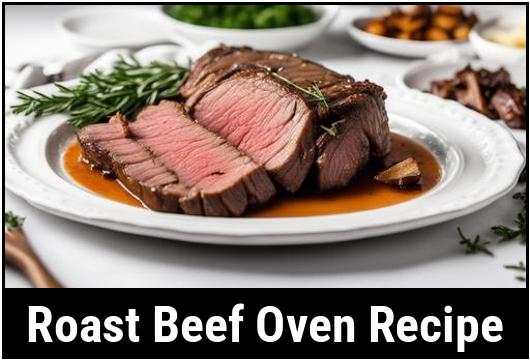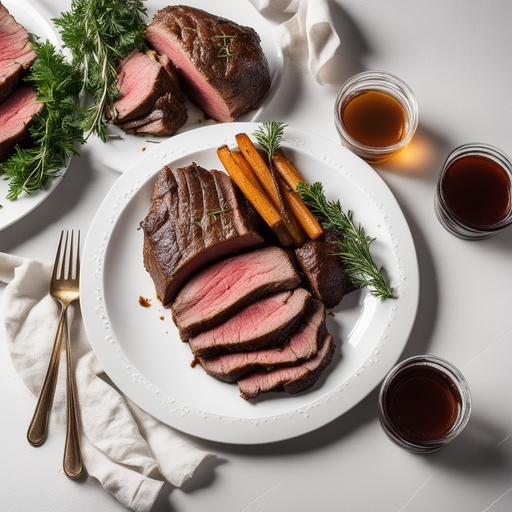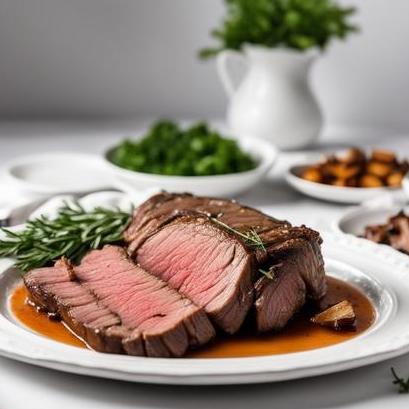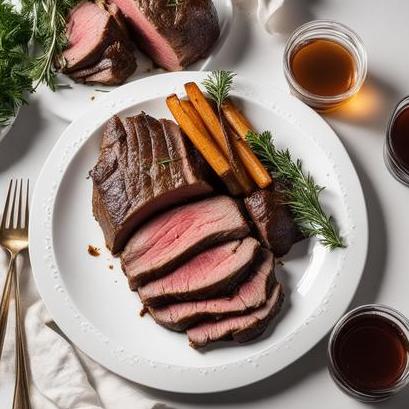
The Ultimate Roast Beef Oven Recipe: Impress Your Guests With A Perfectly Cooked Dish
Are you looking for a hearty and savory meal that is perfect for any occasion? Look no further than the classic roast beef, tender, juicy, and flavorful. While it might seem daunting to prepare such a dish, with the right techniques and equipment, anyone can become an expert cook. In this comprehensive guide, we’ll take you through everything you need to know about roast beef oven recipe, from selecting the best cut to mastering the perfect doneness. Get ready to impress your guests with a mouth-watering meal!
Food Science: Understanding the Cut and Cooking Method
Before diving into the preparation and cooking process, it’s essential to understand the science behind the meat and cooking method. Roast beef refers to beef that is roasted hot and fast, typically in an oven, resulting in a caramelized crust with a juicy and tender center. Overall, the cooking method used for roast beef oven recipe relies on high heat and low moisture, which helps to develop flavor and a crusty exterior while preserving the meat’s moisture.
Choosing the right cut of beef is also integral to cooking the perfect roast. The best cuts for a roast beef oven recipe are typically those that have a good amount of fat, which ensures that they remain moist and tender during the cooking process. Some popular cuts for roast beef include rib-eye, tenderloin, and sirloin. However, the most important factor to consider when choosing a cut for roast beef is its tenderness. The more tender the cut, the less time it will take to cook and the more tender it will be when serving.
Selection and Cleaning: Choosing the Right Cut and Preparing It
When selecting your roast beef, it’s important to look for meat that is firm to the touch, with a deep red or purple color. Avoid any meat that has a greyish tint, as this indicates that it is no longer fresh. Additionally, the amount of marbling (fat) throughout the meat will also affect the cooking time, texture, and flavor. Always look for meat that has a good amount of fat distributed evenly throughout the cut.
Before preparing your roast beef, be sure to clean it thoroughly by removing any excess fat, sinew, and silver skin. This will help ensure that your beef cooks evenly and has a smooth texture. Using a sharp knife, make small cuts on the meat’s surface to help reduce its thickness and help it cook evenly. Then, pat the meat dry with a paper towel before continuing with the recipe.
Preparation: Adding Flavor and Seasoning

One of the most crucial aspects of preparing roast beef is adding flavor and seasoning to enhance its natural flavor. There are countless techniques for seasoning and flavoring beef, including using a wet rub, marinade, or seasoning blend. However, one of the simplest and most common methods is to use a dry rub.
To make a dry rub, you can mix together a blend of herbs, spices, and salt. Some popular herbs and spices for roast beef include garlic, thyme, rosemary, black pepper, and mustard powder. You can also add other seasonings like onion powder, paprika, and cumin to add more depth to the flavor.
Rub the mixture evenly over the entire surface of the meat, making sure to cover it entirely. Alternatively, you can also apply the seasoning to the meat a few hours ahead of time to allow it to penetrate the meat and develop a deeper flavor.
Tips for Perfect Roast Beef Oven Recipe

Now that you’ve prepared your roast beef and added flavor, it’s time to move on to the cooking process. Here are some essential tips to keep in mind to ensure that your roast beef turns out perfectly:
-
Bring the meat to room temperature before cooking it; this helps it cook more evenly.
-
Use a digital meat thermometer to monitor the meat’s temperature during the cooking process.
-
Let the cooked beef rest for at least 10-15 minutes before slicing to allow the juices to redistribute through the meat.
-
Use a meat carving knife or a serrated knife to slice the beef for optimal results.
Doneness Checks: How to Know When Your Roast Beef is Cooked

One of the most challenging aspects of cooking roast beef is achieving the perfect level of doneness. Because cooking time varies depending on your oven, the cut of meat, and the size of your roast, it’s essential to check doneness throughout the cooking process.
Here are the different stages of doneness for roast beef:
-
Rare: 120-125°F
-
Medium-rare: 130-135°F
-
Medium: 140-145°F
-
Medium-well: 150-155°F
-
Well-done: 160°F and above
To check the doneness of your roast beef, insert a digital meat thermometer into the center of the roast, making sure not to touch any bones. For rare beef, aim for a temperature of 120-125°F. For medium-rare, aim for around 130-135°F. For medium, aim for 140-145°F. For medium-well and well-done, aim for a temperature of 150-155°F and 160°F or above, respectively.
Classic Roast Beef Oven Recipe

Now that you’ve learned all the essential tips and tricks for cooking perfect roast beef, it’s time to put your skills to the test with this classic roast beef oven recipe:
Ingredients:
-
1 (4-pound) beef rib roast
-
1 tablespoon kosher salt
-
1 tablespoon freshly ground black pepper
-
2 tablespoons chopped fresh rosemary
-
2 tablespoons chopped fresh thyme
-
2 cloves garlic, minced
-
2 tablespoons olive oil
Instructions:
-
Preheat your oven to 450°F.
-
In a small bowl, combine salt, black pepper, rosemary, thyme, garlic, and olive oil.
-
Rub the mixture over the entire surface of the meat.
-
Place the beef on a roasting rack in a roasting pan.
-
Cook for 15 minutes, and then reduce the oven temperature to 325°F.
-
Continue to cook for about 1 ½ – 2 hours, or until the meat reaches your desired degree of doneness.
-
Remove from the oven and allow the beef to rest for at least 10-15 minutes.
-
Slice the beef and serve immediately.
Congratulations! You’ve just cooked a perfect roast beef oven recipe. Enjoy!
Variations: Experiment with Different Flavor Combinations
One of the best things about roast beef is that it pairs well with a wide variety of flavors and ingredients. Experimenting with different seasonings, spices, and herbs can help you create a custom flavor profile that is suited to your preferences.
Some popular variations to try include:
-
Garlic and thyme: Using fresh garlic and thyme adds a warm and rich flavor to your beef.
-
Rosemary and lemon: The bright and refreshing flavor of lemon pairs perfectly with the earthy flavor of rosemary.
-
Mustard and honey: Combining mustard and honey creates a sweet and tangy flavor that adds dimension to your beef.
Overcooked and Undercooked Beef: What to Do
Sometimes, even with all the best intentions, your roast beef oven recipe can go wrong. If you find that your beef is overcooked, don’t worry, you can salvage it by adding sauces or gravies. Just be sure not to add any salty ingredients, as overcooked beef tends to be saltier.
Similarly, if your beef is undercooked, you can return it to the oven and continue cooking it until it reaches your desired level of doneness. However, if you have already sliced your beef and find it to be undercooked, you can quickly reheat it by searing it in a pan before serving.
Final Words
We hope this comprehensive guide to roast beef oven recipe has given you all the knowledge and confidence you need to make a delicious and perfectly cooked dish. Whether you’re hosting a dinner party or looking for a hearty weeknight meal, roast beef is sure to impress even the pickiest of eaters. Remember to have fun experimenting with different flavor combinations and techniques. Happy cooking!
FAQS On Roast Beef Oven Recipe
What Cut Of Beef Is Best For Roast Beef In The Oven?
The best cut of beef for a roast beef oven recipe is a well-marbled piece such as a rib-eye or a chuck roast. These cuts have just the right amount of fat to keep the meat tender and moist during the cooking process.
Should I Marinate The Beef Before Cooking It In The Oven For A Roast Beef Recipe?
While marinating is not necessary for a roast beef oven recipe, it can add an extra layer of flavor to the meat. If you choose to marinate, use a simple combination of olive oil, Worcestershire sauce, garlic, and your choice of herbs to enhance the taste of the beef.
How Long Should I Cook The Roast Beef In The Oven?
The cooking time for your roast beef in the oven will depend on the size of the roast and the desired level of doneness. As a general guideline, plan to roast the beef for about 20 minutes per pound at 325°F (163°C) for medium-rare doneness. Use a meat thermometer to check for an internal temperature of 135°F (57°C) for medium rare or adjust accordingly for your preferred level of doneness.
Should I Sear The Beef Before Roasting It In The Oven?
Searing the beef before roasting is an optional step but highly recommended. Searing helps to develop a rich and flavorful crust on the meat, improving both the taste and appearance of your roast beef. Heat a heavy-bottomed skillet over high heat, add a small amount of oil, and sear the beef on all sides until browned before transferring it to the oven.
How Should I Carve The Roast Beef After It’s Cooked?
Allow the roast beef to rest for at least 15 minutes before carving to ensure the juices redistribute throughout the meat. Trim any excess fat or twine and slice the beef against the grain into thin, even slices for optimum tenderness. Use a sharp carving knife or an electric knife for clean, precise cuts.



